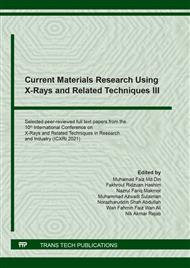p.39
p.49
p.54
p.62
p.68
p.74
p.80
p.86
p.92
Physiochemical Properties of Biofilm from Dioscorea hispida Starch Blended with Glycerol Extracted from Recycling Cooking
Abstract:
Glycerol is a by-product produced from biodiesel production through the transesterification process. The excessive amount of glycerol generated during this process may become an environmental problem since it cannot be disposed on the environment. One of the possible applications is its use in biofilm production as a plasticizer. This research aims to characterize the physicochemical properties of biofilm produced from Dioscorea hispida (Ubi Gadong) starch with a different formulation of glycerol extracted from recycling cooking oil. Dioscorea hispida starch has shown great potential as a major component in bioplastic production due to its faster degradation rate, while glycerol acted as a plasticizer. The contact angle, water absorption, water content, and degradation rate of biofilm were also studied. Biofilm with the highest ratio of glycerol content showed the highest water absorption, which achieved 75.75%, and the biodegradable rate of biofilm was 97.99% on day 3. The lowest glycerol content in biofilm showed the lowest contact angle and completely biodegradation after five days buried in the soil.
Info:
Periodical:
Pages:
68-73
Citation:
Online since:
January 2022
Keywords:
Price:
Сopyright:
© 2022 Trans Tech Publications Ltd. All Rights Reserved
Share:
Citation:


